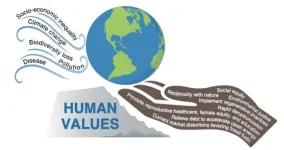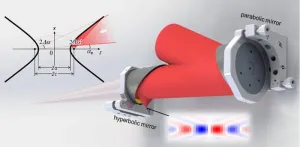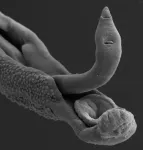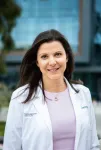Soil contains about twice as much carbon as the atmosphere and plants combined. It is a major carbon sink, capable of absorbing more carbon dioxide from the atmosphere than it releases. Management of soil carbon is key in efforts to mitigate climate change, in addition to being vital to soil health and agricultural productivity.
Measuring soil carbon, however, is a painstaking, expensive process. Samples must be dug from the ground and sent to a lab for analysis, making upscaling measurements on a large spatial scale challenging.
Now environmental scientists have combined field-level data with machine-learning techniques to estimate soil organic carbon at the U.S. continental scale. The Journal of Geophysical Research — Biogeosciences published the new soil organic carbon estimate, which improves the overall estimate for the United States and gives new insights into the effects of environmental variables on soil organic carbon.
“There is growing recognition that soil organic carbon is important and that we should invest in building it up through sustainable land management practices,” says Debjani Sihi, senior author of the study and assistant professor of environmental sciences at Emory University. “Our estimate is more accurate than existing estimates and provides a better benchmark to guide policymakers and land managers in adopting climate-smart practices.”
Land is far more efficient than the ocean at retaining carbon, Sihi notes, and offers one possible nature-based solution to help mitigate climate change.
“We could potentially create conditions,” she explains, “that are favorable for soil to capture carbon dioxide from the atmosphere and lock it there for a really long time — over millennia.”
Sihi is a biogeochemist who studies environmental and sustainability issues at the nexus of soil and climate.
First author of the current paper is Zhuonan Wang, a former postdoctoral fellow in Sihi’s lab who is now at Colorado State University.
Digging into soil data
Soil organic carbon is made up of plant and animal matter in various states of decomposition. While inorganic carbon is also found in the soil in the form of carbonate minerals, organic carbon is usually the largest proportion and the most important driver of soil biology and quality.
The U.S. Department of Agriculture maintains the National Cooperative Soil Survey soil characterization database. This data was gathered over decades both by walking over the land and observing and by digging up core samples and sending them to laboratories for analysis. Measuring soil organic carbon, for example, requires digging a core to the root zone, about 30 centimeters deep to obtain a topsoil profile and until the core hits bedrock to obtain an entire soil profile.
Soil sampling is done in other parts of the world as well. The International Soil Organic Carbon Network encompasses more than 430,000 soil profiles, drawn from across the globe. Scientists use such data to create “soil maps,” or estimates of soil characteristics in various regions. One well-known soil map is the Harmonized World Soil Database, developed by the United Nations’ Food and Agricultural Organization and collaborators. Another is SoilGrids, supported by the International Soil Reference and Information Center in the Netherlands.
Significant inconsistencies exist in the estimates of soil organic carbon within both the Harmonized World Soil Database and SoilGrids. Sihi and her team set out to see if they could resolve these inconsistencies within the United States estimates by finding more effective ways to scale up the soil-sampling data.
The researchers divided the United States — including all 50 states and Puerto Rico — into 20 different regions and created machine-learning models for each region. They obtained nearly 50,000 soil samples, ranging from 30 centimeters to one meter deep, from across these regions. They built their algorithms using these data samples for soil organic carbon, matched to precise geographic information system locations.
They also drew from additional open-source data to feed their models with 36 environmental variables, including details about the climate, topographical features of the land, biogeochemical properties of the soil and the amount of vegetation on the landscape.
A better benchmark for modeling Earth systems
The results showed that the new method provided more accurate estimates than both the Harmonized World Soil Database and SoilGrids for the top 30 centimeters of soil, where the most biologically active soil organic carbon tends to be concentrated.
The new method also revealed how the effects of environmental variables on soil organic carbon vary across regions. While climate was the most common predictor of soil organic carbon across most of the regions, the vegetation index tended to be more important in the arid areas of the southwest. Elevation was a key variable in regions that were mountainous or included a major river delta.
The researchers hope that others will apply their approach to other countries and continents where enough on-the-ground data is available.
“The beauty of our approach is that it gives us the power to identify regions with high uncertainty in our estimates and that helps us to guide future sampling efforts,” Sihi says.
Considering environmental variables also increases the new model’s flexibility as global temperatures rise due to climate change, causing soils to warm and alter rainfall patterns. It remains unclear, Sihi notes, if soils will continue to serve as a carbon sink or transform into a carbon source.
“To understand how soil carbon will change under a changing climate, we first need accurate estimates of current soil organic carbon levels and the key factors that influence them,” Sihi says. “Our new estimate is a step toward getting more accurate baseline data to improve Earth system models for climate change.”
Co-authors of the new estimate include Jitendra Kumar (Oak Ridge National Laboratory), Samantha Weintraub-Leff (National Ecological Observatory Network), Katherine Todd-Brown (University of Florida) and Umakant Mishra (Sandia National Laboratories).
The work was supported by the National Science Foundation and the U.S. Department of Energy.
END





